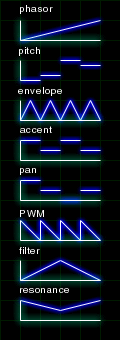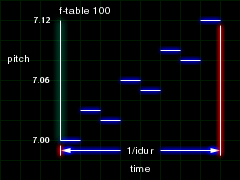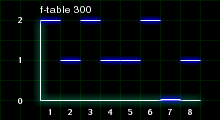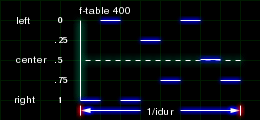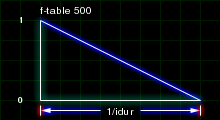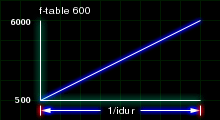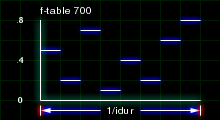
Analogue sequencers are great because they force you to rethink the way you compose music. The interface of any synthesizer can have a significant influence on the music a person writes. With Csound, we design our own interfaces to use in our score. We determine how each instrument uses the p-fields.
Designing a step sequencer is no exception. Very little is actually required to build a step sequencer in Csound. This is also a great lesson for designing more elaborate instruments.

How to Build a Step Sequencer

The method used for this instrument primarily uses a master PHASOR, f-tables and TABLE.
To properly sync everything in our step sequencer, we want to create a master PHASOR. Once the PHASOR is created, every component reads from this master phasor. You can think of the PHASOR as a master clock in some respects.
Let's take the time to add each component one at a time so that you can get a feel of how an instrument is built top down.

Creating the Master Clock

The master clock is built from a PHASOR. The PHASOR run at '1/idur' in order to play all the notes once, regardless of the designated time length in p3. This also allows the user to specify different time lengths to easily change the tempo of a pattern.
Here, we created the phasor at an a-rate. A sister clock is created by taking our aclock and downsampling it to a k-rate. This is done because not all the opcode parameters used can take an a-rate value. We could have created a seperate kclock and this would have worked just fine. This method here is a little bit more clean and effiecient.
aclock phasor 1/idur
kclock downsamp aclock

FTLEN

If we are going to store notes in an f-table, we might as well take advantage of some of our availabe options that an f-table allows us. For instance, instead of designing a step-sequener that plays 16 notes each time no matter what, we can allow our step-sequencer play as many notes as we choose to put in our f-table. Maybe we want only to play 8 notes or maybe 32. FTLEN allows us to automate our instrument.
The FTLEN opcode seeks out an f-table and returns the size of that f-table.
f1 0 8192 10 1
f2 0 16 -2 1 2 3 4 5 6 7 8 9 10 11 12 13 14 15 16
isize = ftlen(1)
isize2 = ftlen(2)
The value that FTLEN gives to isize is 8192 and the value of isize2 is 16.
And we don't have to worry about standardizing our TABLE multiplier by a fixed number when generating an sound.
atable table aphasor * 8192 ; standadized
vs.
atable table aphasor * isize ; now our ifn can be any size.

Variable Names Designed to Make Life Easier

Designing better instruments doesn't just mean how the instrument works internally, but also other details like what to name our variables. It's true we can name our variables anything we want, give them pet names or just a number value. Or we can name our variables to tell us useful information, like what the variable does.
In this instrument, I've organized the names of my variables so I will know more about how and where the variable was created.
f = function table
l = length
t = TABLE
ex: ifenv
In know that ifenv is a fixed value. There is an f, so I know that the data in this variable come directly from an f-table found in the score. And I have env, to let me know that this variable is used for an envelope.

The VCO

Instead of using an OSCIL to generate the audio, I'm using an opcode called VCO (voltage controlled oscillator.) This opcode has a built in saw wave, pulse width modulation and a triangle/saw. I've designed this instrument to use this opcode so that everytime the instrument is triggered, a different traditional waveform can be selected.
iwave = p5 ; 1 = saw, 2 = PWM, 3 = triangle/saw
This opcode allows us to easily change to traditional analogue wave shapes and to dynamically control the pulse width.

Taking advantage of the f-table

We can use function tables for much more than creating waveshapes and storing envelope shapes. We can store data for anything we want. Storing a series of pitches in an f-table saves the user time when composing a piece. Using f-tables to store information such as pan position, resonance of a filter and pulse width modulation.

Pitch Table

The pitch component grabs pitches from a stored function table in the score. The proper gen table to use for cases like this is GEN02. GEN02 allows the user to give a specific value for each point in the gen table. This is different from other GENs like GEN10 that use an algorithm to generate data and plot the data into the table. When creating the GEN, use -2. This causes the table not to rescale value range from -1 to 1.
In this instrument design, the length of the pitch table also determines the master length of the instrument stored in ilength by using FTLEN. This information is used by other components in the instrument. For example, if there are 8 pitches, 8 is used as a multiplier for the envelope component, so that the envelope cycles through 8 times (one envelope for each not.)
| 501.orc |
|
|
|
|
|
|
|
| instr 1 |
|
|
|
| idur |
= |
p3 |
|
| iamp |
= |
p4 |
|
| iwave |
= |
p5 |
|
| ifpch |
= |
p6 |
|
| ilength |
= |
ftlen(ifpch) |
|
|
aclock |
phasor |
1/idur |
|
kclock |
downsamp |
aclock |
|
ktpch |
table |
kclock * ilength, ifpch, 0, 0, 1 |
|
kpch |
= |
cpspch(ktpch) |
|
avco1 |
vco |
1, kpch, iwave, .5, 1, 1/(cpspch(7.00)) |
|
avco2 |
vco |
1, kpch * .994, iwave, .5, 1, 1/(cpspch(7.00)) |
|
avco |
= |
(avco1 + avco2) * .5 * iamp |
|
agate |
linseg |
0, .015625, 1, idur - .03125, 1, .015625, 0 |
|
outs |
avco * agate, avco * agate |
| endin |
|
|
|
| 501.sco |
|
|
|
|
|
|
|
|
|
|
|
|
|
|
|
|
|
|
|
|
|
|
|
| f1 |
0 |
8192 |
10 |
1 |
|
|
|
|
|
|
|
|
|
|
|
|
|
|
|
|
|
|
|
| f100 |
0 |
8 |
-2 |
7.00 |
7.03 |
7.02 |
7.06 |
7.05 |
7.09 |
7.08 |
7.12 |
|
|
|
|
|
|
|
|
|
|
|
|
| t |
0 |
90 |
|
|
|
|
|
|
|
|
|
|
|
|
|
|
|
|
|
|
|
|
|
| i1 |
0 |
4 |
10000 |
2 |
100 |
|
|
|
|
|
|
| i1 |
+ |
2 |
10000 |
1 |
100 |
|
|
|
|
|
|
| i1 |
+ |
2 |
10000 |
1 |
100 |
|
|
|
|
|
|
| e |
|
|
|
|
|
|
|
|
|
|
|

Envelope

The envelope component works by taking an envelope shape stored in an f-table and cycling through it for as many notes as there are in the pitch table. Notice that one of the TABLE multipliers is ilength.
The other multiplier is ilenv. ilenv tells us the size of the f-table which the envelope resides. This is very convienient for the user because he or she doesn't have to worry about making sure the f-table size is always at a constant 256. All stored envelopes can be of different length without breaking the instrument.
atenv table aclock * ilenv * ilength , ifenv, 0, 0, 1


